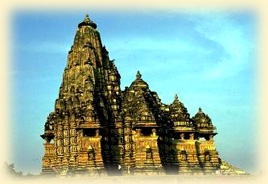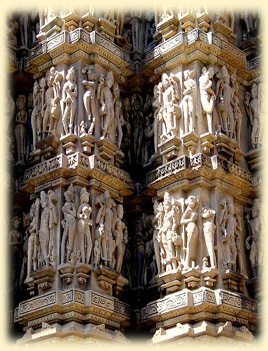Western Group of Temple Khajuraho
|
|
The temples of Khajuraho are the India's unique gift to the world. During the rule of the Chandela dynasty, 85 magnificent and richly cared temples were built near
Khajuraho. Within a period of 100 years i.e. from 950 to 1050 AD, all the temples were completed. But now, out of 85 temples, only 22 temples have survived. These temples are a collective salute to life, joy and creativity. The architectural style of the Khajuraho temples was very different from the temples of that period. The three main compartments of the temple are the entrance
(Ardha Mandapa), assembly hall (Mandapa) and an inner sanctum
(Garbha-griha). The temples are divided into three geographical groups mainly, Western Group, Eastern Group and Southern Group. |

|
|
Western Group of Temples, Khajuraho
The Western group is the best known group of temples. The Kandariya Mahadeo temple which is the largest and most typical Khajuraho temple belongs to this group. This temple is about 31 metres high. The main temple is in an almost perfect state of preservation. The temple has an exquisitely carved entrance arch. On the entrance the images of celestial bodies, lovers, musicians are beautifully carved. Beyond the archway of the Kandariya Mahadeo are the portico, main hall, transept, vestibule, sanctum and ambulatory. The ceiling is very beautiful and the pillars supporting it have intricately carved capitals. The transept's outer walls have three horizontal panels showing deities of the Hindu pantheon and groups of lovers.
|
|
 |
Another temple is the Chaunsat Yogini Temple. This temple is one of the three granite temples in Khajuraho. This temple is dedicated to the goddess Kali and is quadrangular in shape. But now out of 65 cells only 35 cells remain and the image of goddess Kali also does not survives. This temple is one of the earliest shrines, dating back to 900 A.D.
The Devi Jagdambe Temple is another Kali temple, which was originally dedicated to God Vishnu. North of the Devi Jagdambe temple and facing eastwards to the rising sun, is the Chitragupta Temple. This temple is dedicated to
Surya, the Sun God. The image of the god is about 5 feet high, and it drives a seven-horsed chariot. The group scenes depicted on the walls of the temple are equally spectacular with royal processions, elephant fights, hunting scenes and group dances. These images represents the lavish lifestyle of the Chandela kings and their courts.
|
|
|
The Vishwanath temple's architecture is same like the architecture of the Kandariya Mahadeo Temple. The steps leading to the temple on the northern side are flanked by lions and on the southern side by elephants. Inside the temple there is an impressive three-headed image of God Brahma. The exteriors of the temple are very beautifully carved. In front of the Vishwanath temple is a Nandi Temple. This temple houses a massive 6 feet high Nandi bull.
Some of the Chandela rulers were devotees of Vishnu and so they built some of the Vaishnavite temples. One of the finest temple is the Lakshmana Temple. The lintel over the entrance shows the trinity of Brahma, Vishnu and Shiva, with
Lakshmi, Vishnu's consort. The sanctum is richly carved and has a three-headed idol of Vishnu's incarnations, Narasimha and
Varaha. The Varaha Temple is another Vaishnavite shrine. In this temple there is an idol of
Varaha, the incarnation of Lord Vishnu which is about 9 feet high. Its surface is covered with figures from the Hindu pantheon.
Some of the temples are now no longer the living places of worship, but a few exceptions are there. Matangeswara Temple is still a living place of worship. This temple is dedicated to Lord Shiva, and has an 8 feet high lingam.
|
 |
|
|
|
|
|